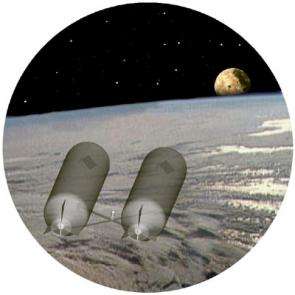Dartmouth researcher proposes the use of high-altitude airships for astronomy

Dartmouth astronomy professor Robert Fesen appreciates NASA's Hubble Telescope, which he says has proven to be a terrific astronomical observatory since it was launched in 1990. But, he adds, there may be a vastly cheaper way to obtain nearly as sharp images of stars and galaxies that doesn't require space shuttle flights or teams of astronauts to launch or repair it.
Fesen has written a new report advocating the use of newly developed military and telecommunications high altitude, station-keeping vehicles for astronomy. He suggests that the time has come to develop and launch what he calls a "Hubble Junior" by placing a relatively modest-sized telescope on one of these stratospheric platforms to conduct astronomical observations.
"A lot of the basic technology exists to make this happen," he says. "High-altitude airships are currently being developed for telecommunications and for the military. I want people to begin thinking about the possibility of doing first-rate optical science like that done from Hubble but at stratospheric altitudes like that flown by the U2 airplane and at a cost of a few million dollars rather than a few billion."
Six years ago, he and some colleagues from NASA, Johns Hopkins University, and the Southwest Research Institute did a feasibility study on this very topic. They determined that it was indeed possible, as long as the payload (the electronics, the mirror for the telescope, and the pointing system) wasn't too heavy. Since then, the technology has greatly advanced, making the notion of using a high-altitude airship for a stratospheric astronomical observatory a real possibility.
An airship, says Fesen, is a propeller-driven balloon. Two blimp-shaped balloons strapped together in catamaran fashion and solar powered could fly at altitudes of 75,000-85,000 feet, or about twice that of commercial airplanes. A one-half- to one-meter size telescope mirror (about 20-40 inches) lofted to these altitudes would place it above more than 95 percent of the Earth's atmosphere, thereby affording nearly razor sharp images of planets, stars, and galaxies.
Fesen is a big fan and a user of the Hubble Telescope. Its 2.4-meter mirror captures beautifully sharp images from its 300-mile-from-Earth orbit. But, he says that a Hubble Junior, at an altitude of just 85,000 feet (16 miles), which would place it above all clouds and weather that plague Earth-bound telescopes, could also acquire nearly as crisp and clear images as Hubble does.
"A one-meter-mirror telescope Hubble Junior, although not as powerful as the real Hubble, could complement Hubble's contributions to our understanding of the heavens. And since it would be more nimble because it's closer to home and simpler to operate, a Hubble Junior could react faster to and follow unexpected supernova explosions, close flybys of asteroids, and other transient astronomical events."
Fesen presented his paper, a roadmap of where the science is and what the possibilities are, at a conference sponsored by SPIE, the International Society for Optical Engineering in late May. He has since posted his paper online.
"What I did was just outline the recipe," he says. "It's now time to start cooking."
Source: Dartmouth College





















